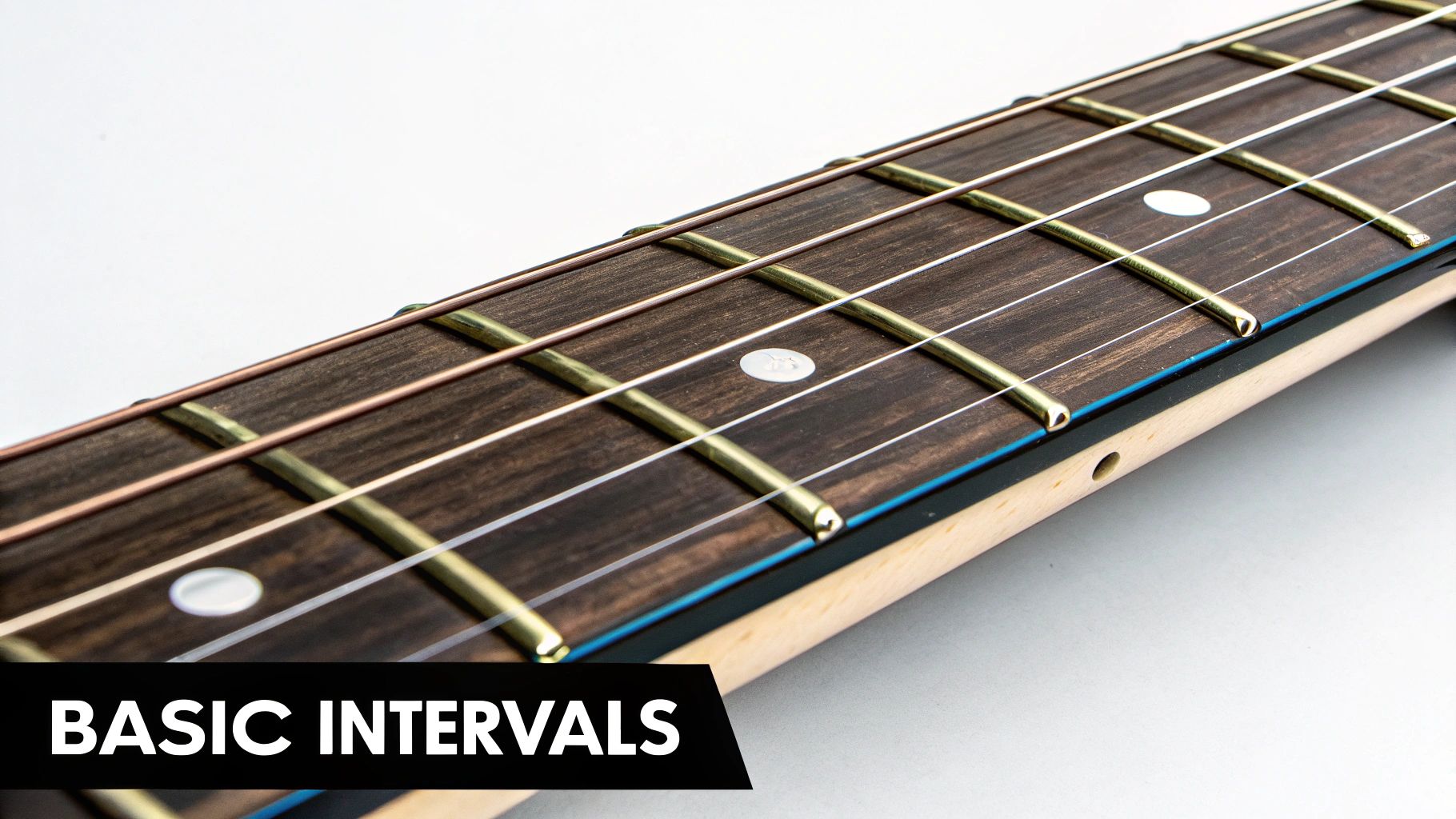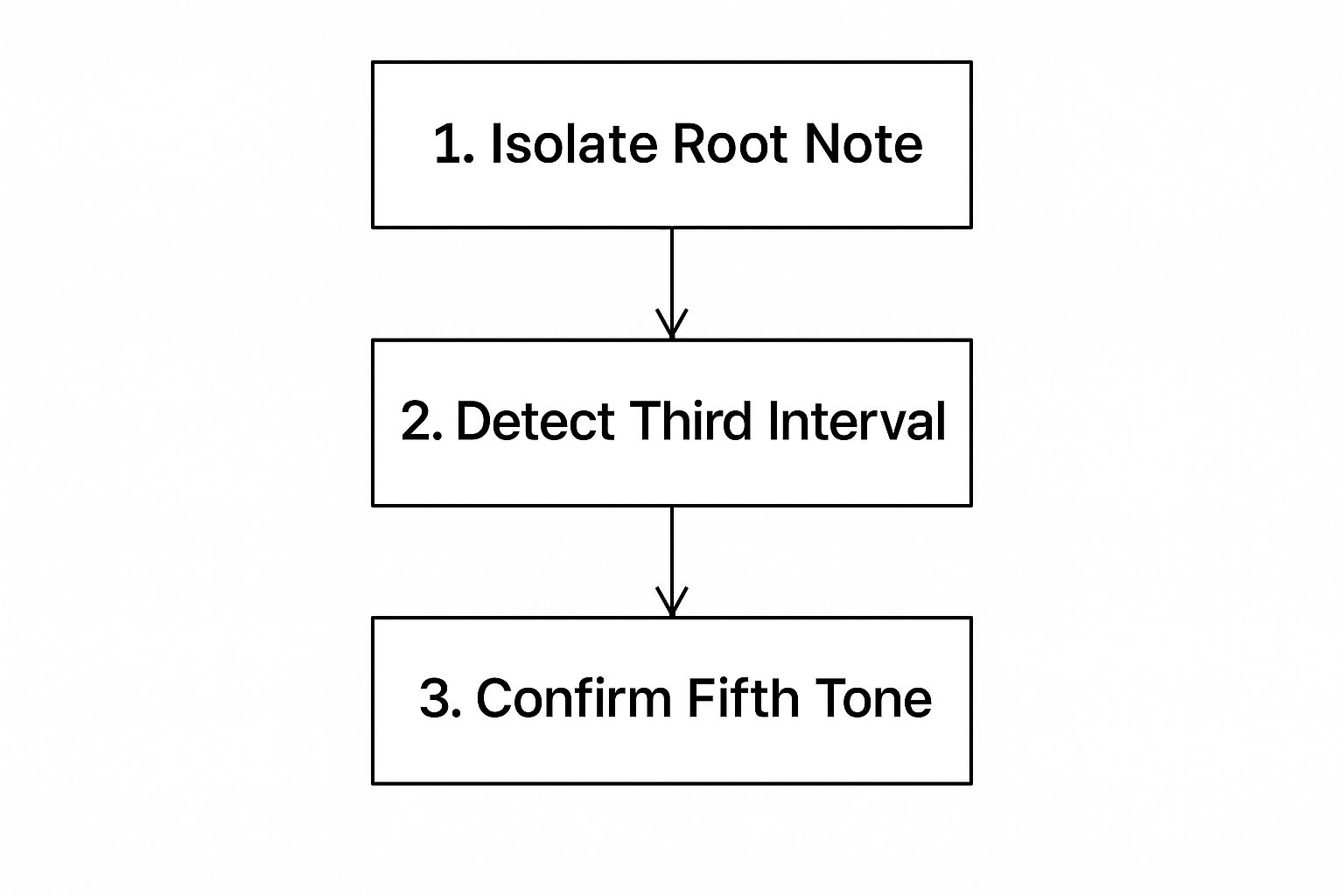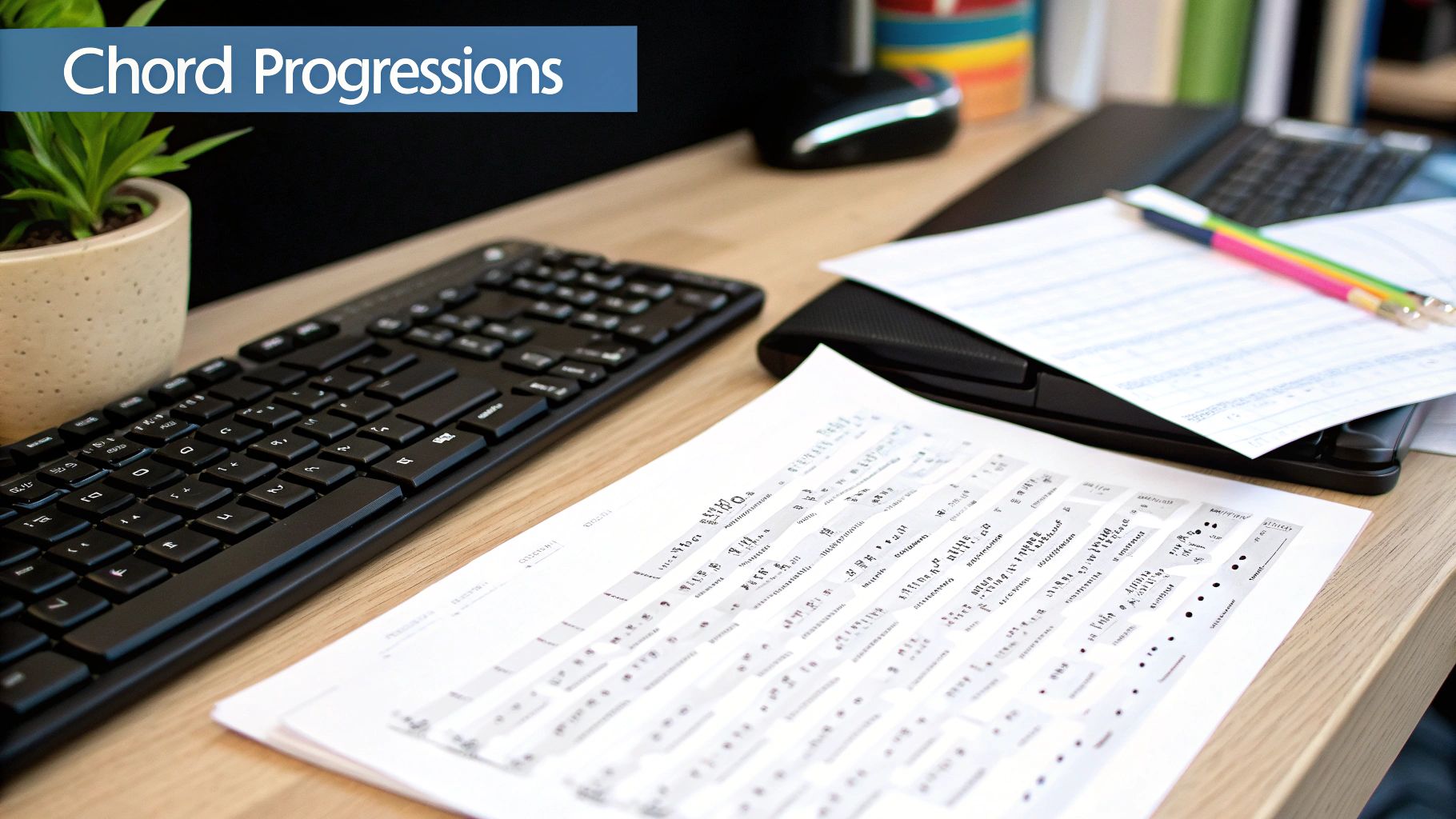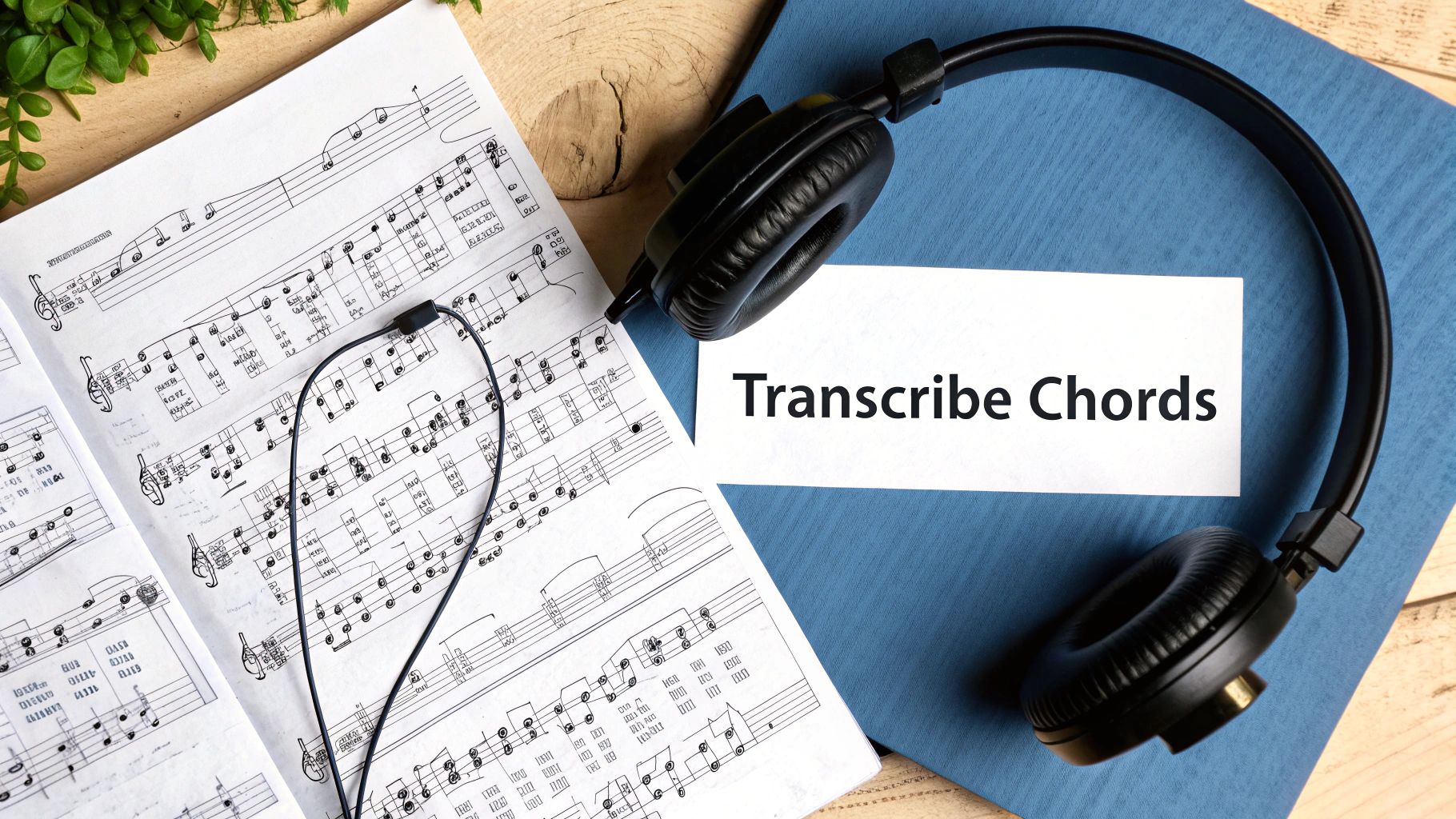How to Hear Chord Changes Like a Pro Musician in 60 Seconds
Learn how to hear chord changes easily with our expert tips. Improve your musical ear today and master listening skills like a professional!
Posted by
Joe BrewerRelated reading
Unlock Music Theory Fundamentals Today
Your journey to understanding music starts here. Our guide makes music theory fundamentals easy, with clear explanations on scales, chords, rhythm, and more.
A Practical Guide on How to Sing in Tune
Struggling with pitch? Learn how to sing in tune with proven exercises, ear training, and pro tips to finally build your vocal confidence and accuracy.
Can You Learn Perfect Pitch? Discover the Truth Today
Wondering can you learn perfect pitch? Explore the science, adult training tips, and how relative pitch plays a role.
How to Hear Chord Changes Like a Pro Musician in 60 Seconds
Learning to hear chord changes isn't some abstract, theoretical exercise. It's about training your ears to feel the emotional and structural shifts that happen when the harmony moves. It’s the process of connecting what you're hearing—the low thud of a bass note, the specific "color" of a chord—to the musical theory behind it. You're basically learning to translate raw sound into a language you can speak.
Why Hearing Chord Changes Is a Musical Superpower

Ever watched a guitarist at a jam session jump in and start playing along perfectly, even though they've never heard the song before? Or wondered how your favorite songwriters come up with progressions that just feel so right? That's not magic. It's a skill, and a learnable one at that.
Knowing how to hear chord changes is the bridge between just playing notes and actually speaking the language of music. It’s a foundational superpower that gives you real musical freedom. When you can identify progressions on the fly, your entire relationship with music changes for the better.
Unlocking Your Musical Intuition
Think about it this way: a chord change is an emotional event. It's the moment a song shifts from happy to melancholic, from a feeling of stability to one of tension, or from asking a question to finding a resolution. Your brain already picks up on these shifts subconsciously every time you listen to music. Ear training just brings that process into your conscious mind.
Once you develop this awareness, a whole new world opens up.
- Learn Songs Way Faster: You'll stop hunting for chord charts and spend more time actually playing. Instead of fumbling around, you'll hear a classic I-IV-V progression and know exactly what's happening.
- Jam with Confidence: You can step into a jam, listen for a minute, and start contributing. No more awkwardly asking, "What are the chords?" Your ears will already have the answer.
- Write More Authentic Music: Songwriting becomes so much more intuitive. You can finally take the harmonies you hear in your head and translate them directly to your instrument, building progressions that capture the exact feeling you're aiming for.
This skill connects you to the very core of musical storytelling. You stop being a passenger following a map and become a driver who understands the road.
A Skill with Deep Roots
This isn't a new concept, either. The journey to understand harmony is built on centuries of musical evolution. Composers like Bach were pushing the boundaries of harmony with complex chords back in the Baroque period, and later, Romantic composers like Chopin introduced even more color and chromaticism. This rich history established the harmonic language we all recognize today. If you're curious, you can explore more about the history of chords and their evolution in music.
Ultimately, learning to hear chord changes is all about pattern recognition. It’s not about having "perfect pitch," but about developing strong relative pitch—the ability to understand how notes and chords relate to one another. This guide is designed to give you the practical, step-by-step exercises you need to build this superpower from the ground up.
Start with the Foundation: Focus on the Bass
If you’re trying to wrap your head around hearing chord changes, the absolute best place to start is with the bass. Seriously. The bassline is your secret roadmap to the song's harmony. Think of the bass player as your guide, laying down the harmonic foundation one note at a time.
This trick works so well because, in most popular music—from rock and pop to country and blues—the bass player almost always plays the root note of the chord. And they usually play it on the strongest beat, typically beat one. So, when the song moves from a C major chord to a G major chord, the bass player will move right along with it, from a C to a G. It’s that simple. You're essentially getting a stripped-down, easy-to-follow version of the entire chord progression.
Your First Actionable Exercise
Let's put this into practice right now. You don't even need your instrument for this.
Pick a song you know well—something simple is best to start. Now, just listen. Put all your focus on the bassline, trying to tune out the drums, vocals, and everything else. See if you can hum along with it. Can you trace its path as it moves up and down?
Once you can confidently hum the bass part, grab your guitar, piano, or whatever you play. Try to find those same notes you were humming. As you pick them out, you'll start to see a pattern emerge. Those notes you're finding? They're the root notes of the chords. This single exercise forges a powerful link between your ear and your instrument, and it’s the first real step toward active listening.
The bass isn't just some low-end rumble filling out the sound. It's the DNA of the chord progression. When you lock into the bassline, you're essentially getting a cheat sheet to the song's harmonic structure.
From Notes to Progressions
As you get more comfortable isolating the bass, you'll begin to notice recurring patterns. For instance, you might hear a bassline that walks from the first scale degree up to the fifth and then back down. That musical movement is a classic signpost; it practically screams "I-V-I," one of the most common and fundamental building blocks in Western music.
This is the mental flowchart I use: once I've got the root note locked in, I can figure out the rest of the chord.

As the visual shows, once your ear finds that root note, you just have to listen for the other key ingredients to determine if the chord is major, minor, or something else.
Training your ear this way is a total game-changer. For anyone looking to sharpen their relative pitch, I've found that consistent, focused listening practice is the only thing that truly works. You can find excellent resources, like those on My ear training journey, that offer exercises built for this exact skill. By spending time just listening to basslines, you're not learning a cheap trick. You're building a deep, intuitive understanding of how music works from the ground up.
Learn to Feel the Emotional Quality of Chords

While following the bass gives you a fantastic road map, music’s real magic is in how it makes you feel. Every chord has its own distinct mood or "color." This is why learning how to hear chord changes is as much about feeling the emotional shifts as it is about picking out notes.
This approach takes you out of your head and puts you straight into the heart of the music. Instead of just hearing a cluster of frequencies, you start to follow the emotional story the harmony is telling. It’s a beautifully intuitive method that works hand-in-hand with the more analytical skill of tracking the bassline. Your job is to connect the sound of a chord to the feeling it sparks inside you.
Major vs. Minor: The Core Emotional Shift
The most fundamental emotional divide in all of Western music is the one between major and minor chords. It’s the sonic equivalent of light and shadow, and it’s the first and most crucial distinction you need to internalize.
- Major Chords: These are your bright, happy, and stable sounds. Think of the chorus to your favorite pop song or the heroic theme from a blockbuster movie. They feel resolved and complete.
- Minor Chords: These are the darker, more reflective, or sadder sounds. They carry a sense of melancholy, tension, or introspection.
Go to a piano or grab your guitar and play a C major chord. Really listen to it. Now, change just one note to make it a C minor—lower the E to an Eb. Hear that? The entire personality of the chord changes in an instant, from cheerful to somber. Getting this single shift deep into your bones is a huge leap forward.
Once you can instantly tell whether a chord is major or minor, you’ve already won more than half the battle. You're no longer just guessing notes; you're interpreting the emotional journey of the music itself.
Adding Tension with Dominant Chords
The next layer of emotion you'll want to tune into is tension. This is the domain of dominant chords. While major and minor chords often feel like destinations, a dominant chord feels like a question mark. It creates an unresolved, restless feeling that practically begs to be released, almost always by moving to a more stable chord.
Think of it as the musical "cliffhanger." When you hear one, your ear instinctively braces for what comes next. A classic example is a G7 chord, which creates a powerful magnetic pull back to a C major chord. Try it yourself: play C major, then G7, then resolve back to C. Feel that cycle of stability, tension, and satisfying release.
As you listen to songs from now on, try to let go of naming every single chord. Instead, just ask yourself simple questions. Did the feeling just change? Did it get brighter or darker? More stable or more tense? This kind of emotional listening trains your intuition, making your recognition faster and more automatic every time you do it.
Recognize the Most Common Chord Progressions
Think about how writers use familiar phrases. They don't invent a new way to say "hello" every time. Musicians are the same; they aren't creating brand new harmonic ideas for every single song. Instead, they’re drawing from a shared language of chord progressions—time-tested patterns that just work.
Learning to spot these patterns is your biggest shortcut in ear training. The real goal isn't just to memorize theory, but to build an internal library of these sounds. When you hear a common progression, it should feel as comfortable and familiar as bumping into an old friend. This is the moment you stop struggling with individual notes and start hearing the bigger musical picture.
The Four Chords That Rule Pop Music
If you're going to master one progression first, make it the I-V-vi-IV (one-five-six-four). I guarantee you’ve heard this sequence thousands of times without even realizing it. In the key of C major, these chords are C - G - Am - F. It’s so widespread it’s often called "the pop-punk progression" or simply "the four chords of pop."
Why is it so popular? Because it tells a perfect little story. It starts on the stable I chord (our home base), moves to the tense V chord (the adventure), lands on the more emotional vi chord (a moment of reflection), and then uses the IV chord to create a feeling of anticipation that pulls you right back home.
Hearing this progression is like recognizing a familiar plot in a movie. You instinctively know the emotional arc—the stability, the tension, the reflection, and the return. This is the foundation of modern songwriting for a reason.
Go listen to these tracks and you'll hear it loud and clear. Train your ear on them:
- "Let It Be" by The Beatles
- "Don't Stop Believin'" by Journey
- "I'm Yours" by Jason Mraz
- "With or Without You" by U2
Focus on the verses or choruses. Once you hear that familiar harmonic movement, you'll have a genuine "Aha!" moment. It's incredibly satisfying when it finally clicks.
Classic Progressions Across Genres
While the I-V-vi-IV is the king of pop, other styles have their own go-to patterns. Adding these to your mental library will make you a much more well-rounded and versatile musician.
The Blues Bedrock (I-IV-V) This is the absolute backbone of blues, early rock and roll, and a ton of country music. It's simple, powerful, and gets the job done. In the key of C, that's just C - F - G. You can't miss it in Chuck Berry's "Johnny B. Goode" or "La Bamba" by Ritchie Valens.
The Jazz Turnaround (ii-V-I) If you have any interest in jazz, this is your bread and butter. The ii-V-I (two-five-one) progression is the sound of resolution in jazz. In C major, that's Dm7 - G7 - Cmaj7. It has a smooth, sophisticated sound you'll hear in countless standards, like the famous "Autumn Leaves."
Don't just take my word for it. A comprehensive study of over 10,000 songs confirmed just how common these patterns are. It found that popular four-chord progressions nearly always featured sequences like C-G-Am-F (our I-V-vi-IV) and C-F-G-C. These classic movements are the building blocks for countless hits. If you're a data nerd, you can explore the full chord progression report to see the analysis.
By actively listening for these patterns, you’re training your brain to latch onto bigger musical chunks instead of just single notes. Before you know it, you'll be able to map out entire sections of songs after just one or two listens—a true sign that your ear is starting to think like a musician's.
Build a Daily Ear Training Practice That Works

Knowing the theory is one thing, but if you want to actually hear chord changes in the wild, consistency is everything. It's what separates the musicians who can from those who can't.
The secret isn't locking yourself in a room for hours. It’s about weaving small, focused ear training exercises into your day. Trust me, 10-15 minutes a day is far more powerful than one long, frustrating cram session on a Sunday afternoon.
You’re building a new mental muscle here. And just like any workout, it takes regular, manageable effort to see real results. The goal is gradual improvement, not overnight magic.
Start with Simple Two-Chord Drills
Your first mission is to make the sound of a basic chord change completely unmistakable. Forget trying to decipher a whole song right away. That's a recipe for frustration. Instead, let's isolate the simplest possible movement: from one chord to another.
Grab a guitar, sit at a piano, or even use an app to loop a simple back-and-forth progression like C major to G7. That's it. Just listen. Let your ear soak in that specific shift—the feeling of moving from a stable "home" base to a point of tension, and then the release of coming back.
Once that starts feeling second nature, switch things up.
- Try moving from a major to its relative minor, like C major to A minor. Can you hear that shift in mood? It’s like the sun going behind a cloud—a change from bright to something more thoughtful.
- Work on a classic IV-I movement, like F major to C major. This is the "Amen" cadence you hear at the end of hymns. Feel how final and resolved it sounds.
This focused practice trains your brain to spot these fundamental building blocks no matter where they pop up.
Hearing chord changes isn't a "gift." It's a skill built through focused, repetitive listening. Eventually, the sound of a harmonic shift becomes as obvious to your ear as the difference between red and blue is to your eye.
Level Up with Tech and Transcription
When you feel ready to push yourself, technology can become an incredible training partner. There are countless ear training apps and websites that play short chord progressions and quiz you on them. This instant feedback is gold because it helps you correct mistakes on the spot and reinforces what you're hearing correctly.
This is also the perfect time to dip your toes into transcription. It’s a time-tested exercise that directly teaches you how to hear chord changes in the context of actual music.
- Pick a Simple Song: Start with something you know has a straightforward, looping progression. Think folk tunes, nursery rhymes, or early rock and roll.
- Focus on a Tiny Snippet: Isolate just the first four bars of the song. Put it on repeat. Don't even think about the rest of the tune until you feel confident about that small piece.
- Grab a Pen and Paper: Try to identify and write down what you hear. A great starting point is to hum the bass notes first—that often gives you the root of the chord. Then, listen for the quality: does it feel happy (major) or sad (minor)?
This will feel slow and maybe a little clumsy at first, but it forges a powerful connection between your listening skills and your musical knowledge.
Interestingly, this task might be getting a little easier over time. Research analyzing over 680,000 songs revealed that harmonic complexity in popular music has been on a downward trend for decades. The median "unique chord rate" in a song has dropped from around 13% in the 1930s to just 8% in the 2020s. This means modern music often relies on fewer, more repetitive patterns. You can read more about these fascinating harmonic trends and what they mean for today's musicians.
Got Questions About Hearing Chord Changes? You're Not Alone.
As you dive into ear training, it’s completely normal to have questions pop up or even feel a bit of doubt creep in. Let's walk through some of the most common hurdles I see musicians face when they’re first learning how to hear chord changes. Getting these things straight in your head can make all the difference in keeping your practice effective and your motivation high.
Think of it like learning a new language. You don't go from knowing zero words to being fluent overnight. First, you pick up a word here and there. Soon, you start recognizing common phrases. Before you know it, you're following the entire conversation. It’s all about steady, gradual immersion.
So, How Long Does This Actually Take?
This is the million-dollar question, right? The honest, no-fluff answer is: it really depends. Your progress is tied directly to how consistently and how well you practice. I've seen students who put in a focused 15 minutes every single day blow past those who cram for two hours once a week. It’s the daily repetition that builds the muscle.
Of course, your starting point matters. If you already have some experience on your instrument and know a bit of theory, you'll probably start connecting the dots within a few weeks. If you're coming in totally fresh, it might be a few months before you feel that solid sense of confidence. The real secret is to notice and celebrate the small victories along the way, like the first time you nail a I-IV-V progression on your own.
The goal isn't to race to some imaginary finish line. It's about making your ears just a little bit sharper today than they were yesterday. This simple shift in mindset turns the focus from "how long will this take?" to "am I getting better?"
What to Do When You Feel Totally Stuck
Everyone hits a wall. It's not a sign of failure; it's part of the learning curve. The absolute worst thing you can do when you feel frustrated is to try and power through it. When your brain gets tired, your listening accuracy takes a nosedive. The best move is to simply step away.
Here are a few tactics that have always worked for me and my students:
- Make the Problem Smaller: Can't figure out a four-chord loop? No problem. Go back to a simple two-chord drill. Go back to what feels easy and build back up from there.
- Change Your Listening Mode: Shift from active, intense transcription to just passive listening. Throw on a song you know inside and out and just follow the bassline. Don't try to name anything, just follow the movement.
- Switch Up the Scenery: Sometimes your ears just need a reset. If you’ve been grinding away on complex jazz changes, put on some simple three-chord folk or blues tunes for a bit. A different sonic texture can be surprisingly refreshing.
Perfect Pitch vs. Relative Pitch: What You Actually Need
Let's clear this up right now: you do not need perfect pitch to become a master at hearing chord changes. Not even close.
- Perfect Pitch is that rare, almost-a-superpower ability to hear a random note—say, an F#—and name it instantly with zero context.
- Relative Pitch is the skill we're actually building. It's the ability to hear the relationship between sounds. It’s what lets you recognize the distinct feeling and sound of a C major chord moving to a G major chord.
Almost every incredible musician you look up to operates on a highly developed sense of relative pitch. It’s the practical, trainable skill that lets you understand music as a language of relationships, not just a series of isolated sounds.
Ready to put all this theory into practice in a way that’s actually fun? The games at My ear training journey are built specifically to develop your relative pitch from the ground up. They make the whole process of learning to hear chord changes feel more like playing and less like work. Start your journey today.